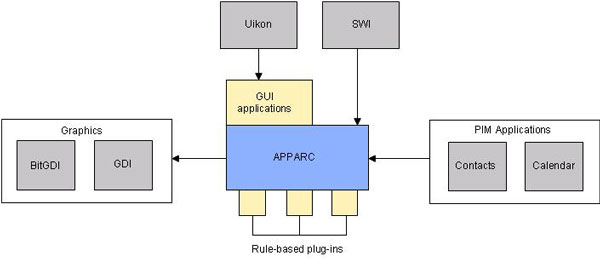Application Architecture Overview
APPARC provides access to a cached list of applications, and their properties, on the device. APPARC also provides a mechanism for launching applications and switching between tasks.
Purpose
The main purpose of APPARC is to
manage and register applications with the device
scan the device for installed applications and associate data types to the applications based on the information in the registration file
load applications and manage the creation and destruction of application objects and document objects
support the registration of non-native applications
define a Server Application Framework, which allows applications to communicate through the client-server architecture
support multiple service types over the client-server link and establish a client-server connection to an already running server application
monitor the lifetime of the server application
define the basic polymorphic interfaces that applications must conform to, such as,
CApaApplicationandCApaDocumentprovide a list of available control panel applications present on the device.
Key concepts and terms
- Server Application Framework
The Server Application Framework provides generic service support over a client-server link, on which real services can be created. A service typically provides a client-side interface that clients can use directly, and a server-side interface that server applications have to implement.
Architecture
The following diagram shows the interaction of APPARC with other components.

The following list describes the interaction between APPARC and each of the components depicted in the APPARC architectural diagram:
APPARC provides the basic behavior for GUI-based applications. APPARC also provides basic behavior for documents in a document-view based application. Uikon builds on the basic behavior that APPARC provides for GUI applications. PIM application components (Contacts and Calendar) derive the basic behavior for GUI-based applications from APPARC.
APPARC maintains a list of installed applications on the device. APPARC supports rule-based application launching which is implemented as ECOM plug-ins. These plug-ins define rules that enable APPARC to either deny or accept the application launch requests.
Software Install (SWI) allows installing, uninstalling and upgrading of native software on the device. When an application needs to be installed, SWI uses APPARC for launching applications if run-on-install or run-on-uninstall is specified.
When an application is launched APPARC interacts with the GDI and BIT GDI components to associate the application with the appropriate application icon, caption and display screen.
API summary
API |
Description |
|---|---|
A class that defines the basic twin roles of an application class: |
|
A class that provides information for launching an application. This class is often referred to as a command line and it contains |
|
The base class for all documents. A document contains the data associated with the content of the application. |
|
A session with the APPARC server providing access to a cached list of applications on the device. |
Typical uses
Developing a GUI-based application
A GUI-based application can be developed using the CApaApplication and CApaDocument interfaces. For more information,
see A Minimal
UI Application.